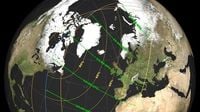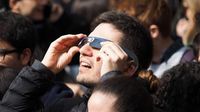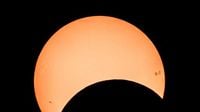On March 29, 2025, a partial solar eclipse captivated viewers across Italy, as the Moon cast its shadow, partially obscuring the Sun. This celestial event was visible from Northern and Central Italy, but regions in the South such as Basilicata, Calabria, Sicily, and southern Puglia were left out of the spectacle. According to the Italian Amateur Astronomers Union (UAI), the peak of the eclipse occurred around noon, depending on the observer's location.
In Rome, for instance, the eclipse began at 11:34 AM and concluded at 12:33 PM. However, the phenomenon was not limited to Italy; it was also observable from Central and Northern Europe, parts of Northwest Africa, and northern regions of Russia and North America. Unlike a total solar eclipse, where the sky darkens completely, this partial eclipse allowed much of the Sun to remain visible.
As the Moon moved in front of the Sun, observers noted that the Sun appeared as a crescent shape, especially in areas where the eclipse coincided with sunrise or sunset. These moments offered a unique view of the so-called 'solar horns,' where the Sun's disk took on a crescent form along the horizon. The partial eclipse was a reminder of the intricate dance of celestial bodies, as the alignment of the Sun, Moon, and Earth was not perfect, resulting in only a portion of the Sun being obscured.
In Italy, the eclipse was visible between 11:21 AM and 12:48 PM, with the maximum coverage of the solar disk reaching only about 13%. In regions like Val d'Aosta and Piedmont, the eclipse coverage was more pronounced, while areas in Tuscany experienced a modest coverage of between 3% and 7%. The event was anticipated by many astronomy enthusiasts, and safety precautions were emphasized for those who wished to observe it directly.
The National Aeronautics and Space Administration (NASA) advised that proper eye protection was essential, as the Sun would not be fully covered at any point. Special eclipse glasses or solar viewers that meet international safety standards were recommended, as regular sunglasses do not provide adequate protection. Observers were warned against using optical devices like telescopes or binoculars without proper solar filters, as this could lead to severe eye damage.
For those unable to observe the eclipse in person, the National Institute of Astrophysics (INAF) offered a live broadcast starting at 11:15 AM. This special broadcast, available on the EduInaf YouTube and Facebook channels, featured expert commentary from Ilaria Ermolli from INAF Rome and Mauro Messerotti from INAF Trieste. They provided insights into the eclipse and answered questions from viewers through live chat, making the event accessible to a broader audience.
As the partial solar eclipse unfolded, many people across Italy and beyond gathered to witness the phenomenon, despite some areas facing challenging weather conditions. Around 11:30 AM, the Sun began to be obscured by the Moon, reaching its peak at noon. This event was particularly significant as it contrasted with the lunar eclipse observed on March 14, which was primarily visible in South America.
Throughout the day, the Moon's passage in front of the Sun created a beautiful display for those positioned in the right spots. The eclipse was noted not only in Italy but also across much of Europe, West Africa, and North America, showcasing the widespread visibility of this astronomical event.
In addition to the live streaming by INAF, other organizations collaborated to enhance the viewing experience. The broadcast was set to continue until 1:30 PM, allowing viewers to enjoy the event even after the eclipse concluded in Italy.
As the eclipse drew to a close, many were left in awe of the natural beauty and scientific wonder of such celestial events. The partial solar eclipse on March 29, 2025, served as a reminder of the intricate connections between the Earth, Moon, and Sun, and the importance of safe observation practices.
In summary, the partial solar eclipse provided a spectacular display for observers across Italy and beyond, with safety measures in place to ensure a safe viewing experience. The event was not only a visual delight but also an opportunity for education and engagement with the wonders of astronomy.




